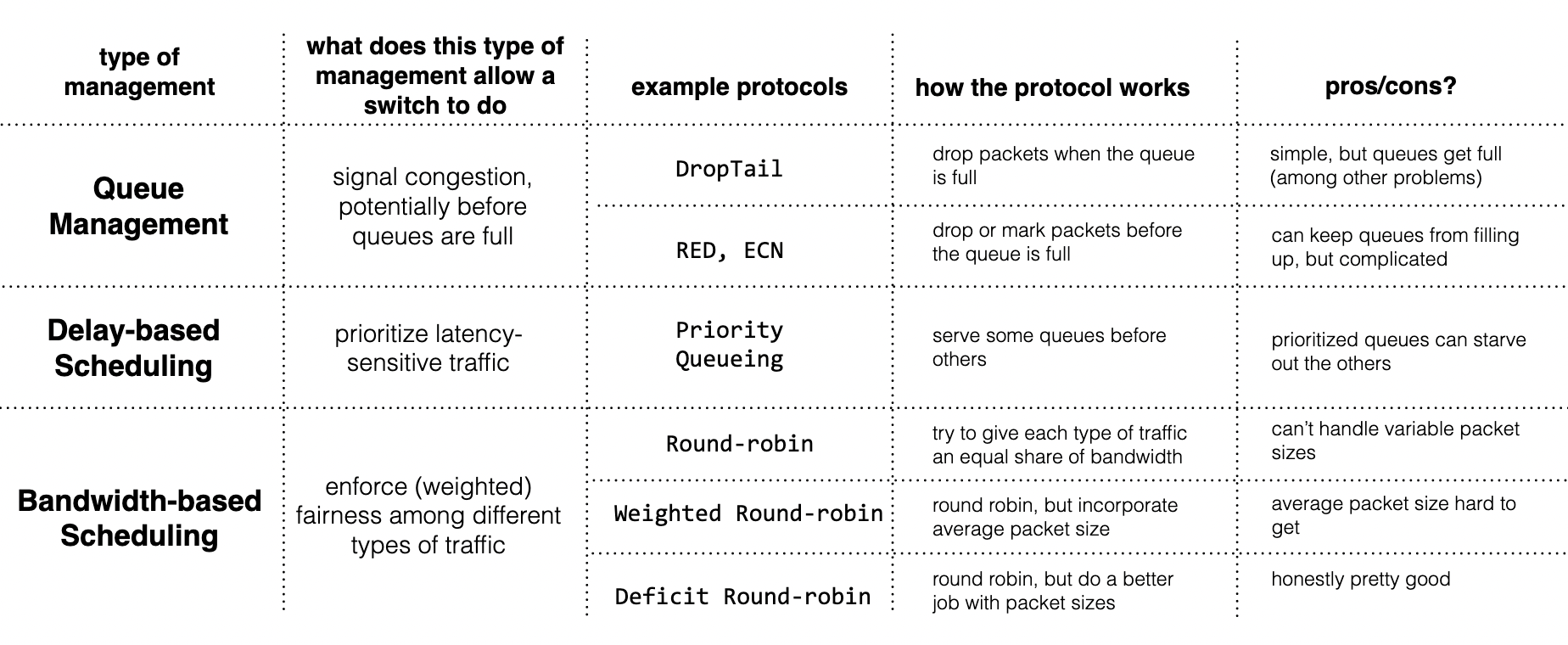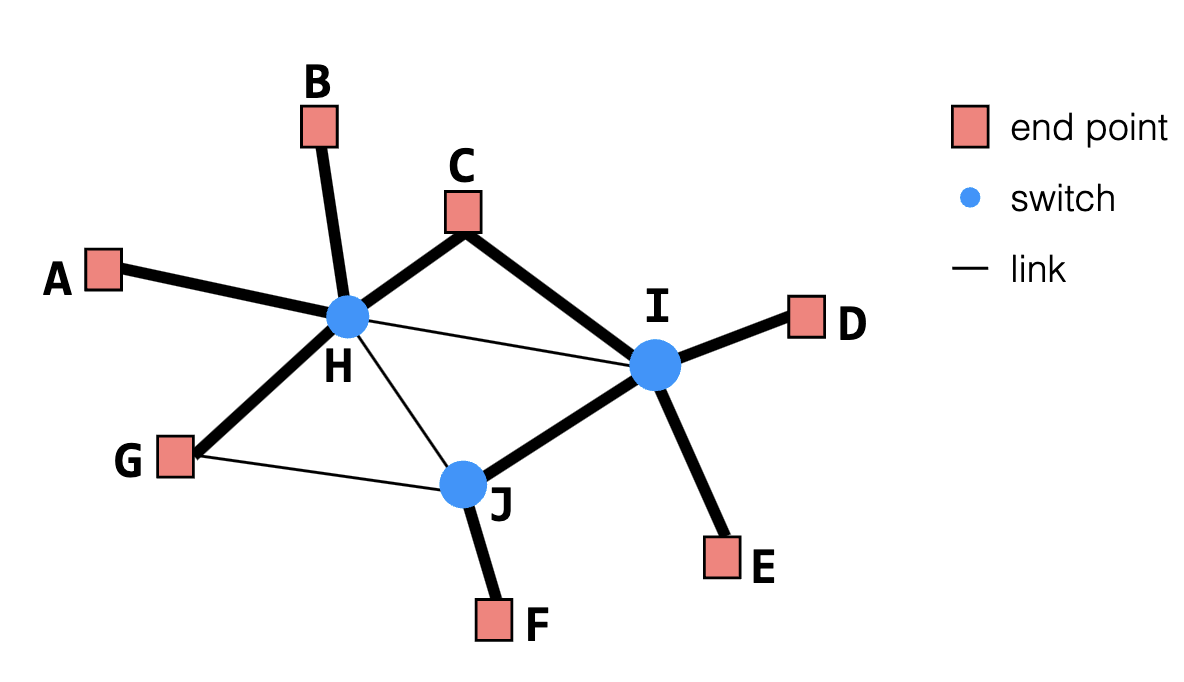SD network
目标:对计算机网络的网络层到应用层有最基本的了解。包括TCP和UDP、IP和应用层分别提供了什么保证,没有提供什么保证;我们能通过他们达到什么目的;我们如何使用他们。
general goal: on the Internet, we have to solve all of the “normal” networking problems (addressing, routing, transport) at massive scale, while supporting a diverse group of applications and competing economic interests.
introduction¶
link -> network -> transport -> application
-
a simple network example
- topology
-
- topology
-
CAIDA’s IPv4 and IPv6 AS Core: Visualizing IPv4 and IPv6 Internet Topology at a Macroscopic Scale in 2020
history view¶

-
make the internet flexible: layered model in 1978
with a layered model, we can swap out protocols at one layer without much (or perhaps any) change to protocols at other layers.
-
reliable transport: TCP 1983
-
scalibility: EGP (1978), DNS (1982)
Problems (history view):
-
Congestion collapse -> congestion control mechanism
-
Commercial use -> policy routing(BGP) (early 90s)
-
Assign addresses in chunks of different sizes -> CIDR
Problems (today):
- Denial of service attack
- security
- mobility
- address space depletion: IPv4 -> IPv6
- congestion control
Routing(hard to scale version)¶
Problems: For every node X, after the routing protocol is run, X’s routing table should contain a minimum-cost route to every other reachable node.
Concept:
-
Path: full path packets will travel.
-
Route: first hop of that path.
-
Link cost
distributed routing protocol: nodes build up their own routing tables, rather than having tables given to them by a centralized authority.
1 | for node in Nodes: |
Analysis:
there are two ways of routing applying distributed routing protocols:
-
Link-state routing: disseminate full topology information so that nodes can run a shortest-path algorithm (Dijkstra)
-
Distance-vector routing: disseminate information about the current costs to each node, rather than the actual topology. A node applies Bellman-Ford algorithm to compute the next-hop node for every destination.
-
Flooding makes link-state robust to failure but the overhead of flooding is overwhelming, close to 2NL advertisements for N nodes, L links.
The good thing of distance-vector routing is the overhead of advertisements cost 2L. However, distance-vector routing incurs issues of couting to infinity when a node has no route to destination B. Some nodes can incorrectly think there’s a route when there isn’t one. A workaround is split horizon, which doesn’t send advertisements about a route back to the node providing the route.
Summary: they are good for very small networks but not good enough for scaling to the size of the internet.
Routing at scale:BGP¶
Concept
BGP: border gateway protocol
policy routing: switches make routing decisions based on some set of policies set by a human. Routing protocol must disseminate enough information to enable those policies.
Problem: why BGP can scale while link state and distance vector can’t?
BGP relationships: customer/provider, peers
Export policies
Import policies
Distributed routing
Problems with BGP
- Scale
- Secure
TCP¶
Concept: reliable transport&congestion control
arguments: Sequence numbers, acknowledgements,timeouts
Problem 0: create a reliable transport protocol, which delivers each byte of data exactly once, in-order, to the receiving application.
Goal: fairness and efficiency.
- Approach 1: sliding-window protocol
-
problem 1: how to decide W? (Drops,delay, bandwidth bottleneck)
assumption: infinite offered load
Improvement 1: congestion control
AIMD (additive-increase/multiplicative-decrease): every RTT(round-trip-time, if there is no loss, W = W + 1; else, W = W/2
-
Issue 1: when remove the assumption, TCP has trouble measuring the fairness.
-
Example: S1,S2 offered load 10 packets/s; S3 5 packets/s.
Result: get max-min fairness:S3 stops increase once it’s sending 5 packets/s. S1 and S2 continue increasing until they reach 7-8 packets/s.
improvement 2: Slow-start: at the start of the connection, double W every RTT.
improvement 3: Fast retransmit/fast recovery: retransmit packet k+1 as soon as four ACKs with sequence number k are received.
- issue 2: TCP doesn’t react to congestion until it’s already happening. -> next lecture
In-network resource management¶
TCP have issues that:
problem 1: long delays when routers have too much buffering
problem 2: Doesn’t work well in some scenarios (DCTCP)
Problem 3: doesn’t react to congestion until queues are full.
Goal: solve problem 3: transient queues.
Idea: manipulate switches to get flexibility.
consideration: we need to think about what the method allows a switch to do? Example protocols? How the protocol works? Pros/cons of each protocol.
A1:Queue management¶
-
drop tail
-
Random early detection
-
explicit congestion notification
A2:Delay-based scheduling¶
- priority queueing
A3:Bandwidth-based scheduling¶
- Round-robin
- weighted round-robin
- deficit round-robin
Discussion¶
let’s think about three ideas in lecture:
-
Traffic differentiation
-
Queue-management
-
In-network resource-management




